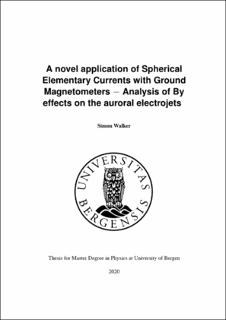| dc.description.abstract | This thesis advances inversion and optimisation techniques used with spherical elementary currents (SECS) to perform a statistical analysis of the auroral electrojets based on ground magnetic field measurements. The divergence-free currents in the northern ionosphere above Fennoscandia are modelled using SECS and constrained by measurements from twenty ground magnetometers. A new regularisation technique is implemented that enables the model to find more physical currents. An electrojet detection algorithm is developed to identify the properties of the auroral electrojets based on the model output. The width, the peak sheet current density and the total current of the electrojet are identified. These electrojet properties are collected with the goal of investigating the so called explicit By effect on the electrojets. This effect refers to the influence of IMF By polarity on the magnetosphere environment. Studies have shown, using the AL index, that the westward electrojet exhibits an explicit By effect that suppresses the westward electrojet during the winter when By is negative and, less significantly, during the summer when By is positive. Investigation into the eastward electrojet, using the AU index, have shown no By effect. The peak SECS derived sheet current density in the westward and eastward electrojet are expected to be similar to the AL and AU indices, respectively. Peaks of the westward electrojet show a variation that is consistent with the explicit By effect during the winter but not during the summer. The peaks of the eastward electrojet show no By effect in either season and, therefore, agrees with the previous studies. The total current through the electrojets provide an improved measure of the strength of the electrojets. The strength of eastward electrojet exhibits no clear explicit By effect. Whereas, the westward electrojet is stronger during the summer when By is negative and, more clearly, when By is positive during the winter. The most interesting By effect was found within the electrojet widths. During the summer, eastward electrojet is wider when By is positive and the westward electrojet is wider when By negative. No such effect is seen during the winter. Through the analysis of average sheet current density profiles and statistical ionospheric convection patterns, this behaviour is attributed to the effects of lobe reconnection. Lobe convection cells influence the poleward boundary of the electrojets found using the algorithm. These lobe cells are greatly affected by the polarity of By and, consequently, create a By effect in the poleward boundary of the electrojets. This may be the first time such a large time series of divergence-free current maps have been analysed. The new electrojet properties found in this study further our understanding of the By effect, while the methodology outlined within this thesis allows for a more effective investigation into divergence-free currents with opportunities to advance the techniques used and expand its application. | |
